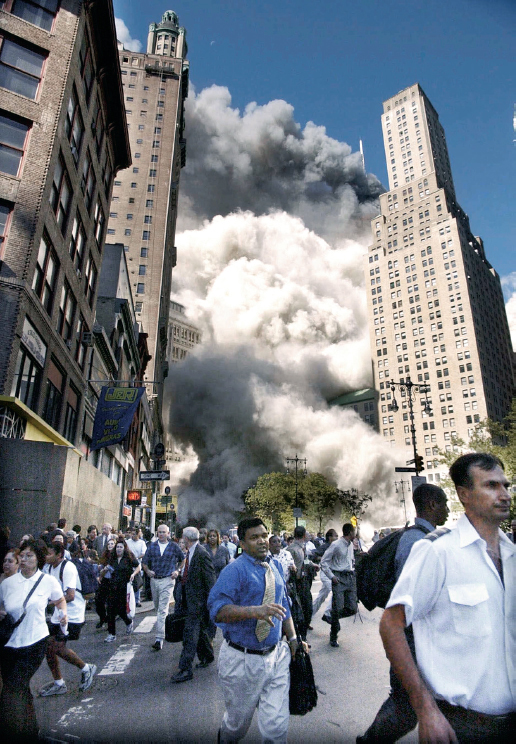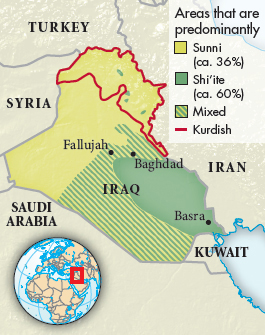Al-Qaeda and Afghanistan
In the Middle East and Central Asia, conflicts that had involved the superpowers continued beyond the Cold War. The 1979 Soviet invasion of Afghanistan, as well as the Iranian revolution, which was followed by the Iran-Iraq War, led to enduring political upheaval that continued to draw the United States into violent conflicts in the twenty-first century.
In Afghanistan rebel groups supported by the United States fought the Soviet armed forces occupying the country, and forced a Soviet withdrawal in 1989. In 1996, after years of civil war, a puritanical Islamic movement called the Taliban filled the military and political vacuum left by the Soviet Union. The Taliban pursued a radical religious transformation of Afghan society, in particular by imposing harsh restrictions on women. The Taliban government provided safe haven in Afghanistan for a terrorist organization called al-Qaeda. In the 1990s, led by Osama bin Laden (1957–2011), al-Qaeda attacked U.S. diplomatic and military targets in Africa and the Middle East.

New York, September 11, 2001Pedestrians race for safety as the World Trade Center towers collapse after being hit by jet airliners. (Amy Sanetta/AP Photo)
On September 11, 2001, al-Qaeda militants hijacked four passenger planes in the United States. They flew two of them into the World Trade Center buildings in New York City and a third into the Pentagon in Washington, D.C. A fourth, believed to be targeting the White House or the U.S. Capitol, crashed into a field in rural Pennsylvania. These terrorist attacks killed almost three thousand people. In response, the U.S. government demanded that the Taliban government in Afghanistan surrender the al-Qaeda leadership it hosted. When the Taliban refused, the United States formed a military coalition including NATO members as well as Russia, Pakistan, and rebel groups in Afghanistan. The coalition mounted an invasion, deposed the Taliban, and pursued al-Qaeda.
After the U.S.-led coalition deposed the Taliban in 2001 and installed a new government in Afghanistan, it faced a protracted guerrilla war against Taliban forces that controlled rural areas. The conflict in Afghanistan spread to Pakistan, where some members of al-Qaeda found refuge, and acts of terrorism increased around the world in the years following the invasion of Afghanistan.
Through years of war, the United States and allied governments devastated al-Qaeda’s leadership and reduced its reach, but local groups acting in conflicts in the Middle East and Africa continued to act under al-Qaeda’s name. Militants with loose ties to al-Qaeda set off multiple bombs in a Madrid train station on March 11, 2004, killing 191 and wounding over 1,800. In London on July 7, 2005, terrorist bombs killed 56 people and injured more than 700. At least three of the bombers were British citizens of Pakistani descent with unclear links to al-Qaeda. A suicide bomber who may have had links to al-Qaeda has also been blamed for the 2007 assassination of Pakistani presidential candidate Benazir Bhutto. In 2011 U.S. intelligence services identified bin Laden’s hideout in Pakistan in a compound located near the country’s main military academy in Abbottabad. In a night raid, U.S. forces killed bin Laden.

Iraq, ca. 2010
U.S. military action against al-Qaeda and the Taliban spilled over into another conflict in the Middle East when the U.S. government invaded Iraq in 2003. In the decade following the conclusion of the Persian Gulf War (1990–1991), Iraq faced international economic sanctions along with constant political and military pressure from the United States to surrender its chemical and biological weapons stockpiles. After 2001, amid the U.S. invasion of Afghanistan, U.S. president George W. Bush accused Iraq of rebuilding its nuclear, chemical, and biological weapons programs. To build domestic support for an invasion, the U.S. government also falsely implied that there were connections between Iraq and al-Qaeda. In 2002 UN inspectors found no weapons of mass destruction. France, Russia, China, Germany, and a majority of the smaller states argued for continued weapons monitoring, and France threatened to veto any resolution authorizing an invasion of Iraq. Rather than risk this veto, the United States and Britain claimed that earlier Security Council resolutions provided sufficient authorization and invaded Iraq in 2003.
A coalition of U.S.-led forces quickly defeated the Iraqi military, and in the power vacuum that ensued, armed groups representing all three main factions in Iraq — Sunni Muslims, Shi’ite Muslims, and Kurds — carried out daily attacks on Iraqi military and police, government officials, religious leaders, and civilians. Estimates of Iraqi deaths since the beginning of the war in 2003 and the U.S. withdrawal in 2011 ranged from 100,000 to over 1 million. Though the U.S. military occupation ended in 2011, the violence continued. Paradoxically, though the connection between al-Qaeda and the government of Saddam Hussein implied by President Bush did not exist, postwar Iraq became a place where militant groups that identified with al-Qaeda proliferated.
What contemporary trends and developments demonstrate some of the limits of liberalism?

